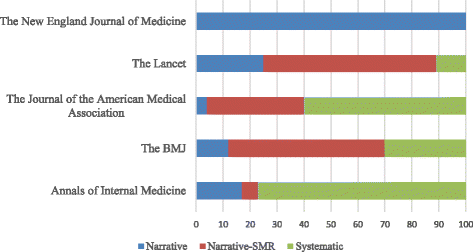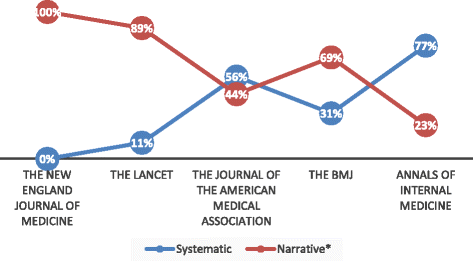A survey of prevalence of narrative and systematic reviews in five major medical journals
- PMID: 29281975
- PMCID: PMC5746017
- DOI: 10.1186/s12874-017-0453-y
A survey of prevalence of narrative and systematic reviews in five major medical journals
Abstract
Background: Systematic reviews may provide less biased evidence than narrative reviews because they observe a strict methodology, similarly to primary studies. Hence, for clinical research questions, systematic reviews should be the study design of choice. It would be important to evaluate the prevalence and characteristics of narrative and systematic reviews published in prominent medical journals. Researchers and clinicians give great value to articles published in such scientific journals. This study sought to evaluate the prevalence and characteristics of narrative and systematic reviews in the five highest-ranked general medical journals and investigate the associations among type of review, number of citations, and impact factor (IF).
Methods: We surveyed the five highest-ranked medical journals (The New England Journal of Medicine, The Lancet, The Journal of the American Medical Association, The BMJ, and Annals of Internal Medicine) for narrative and systematic reviews published between June 2015 and June 2016. We independently selected and extracted the data from the reviews by strictly following the pre-determined eligibility criteria (Systematic and narrative reviews that focused on the management of diseases). We conducted regression analyses to investigate the associations among review type, number of citations, and IF. We also descriptively reported narrative reviews containing some methodology that might be reproducible.
Results: Two hundred seventy-five reviews were included: 75 (27%) systematic; 126 (46%) narrative with some methodology reported, and 74 (27%) narrative reviews. In comparison to systematic reviews, narrative reviews were more frequently published in journals with higher IF (risk ratio [RR] = 1.114 (95% CI 1.080 to 1.149). Systematic reviews received more citations than narrative reviews (group formed by narrative and narrative with some methodology reported (RR = 0.985 95% CI 0.978 to 0.991).
Conclusions: Non-systematic evidence is the most prevalent type of evidence in reviews published in the five highest-ranked general medical journals. Narrative reviews were more frequently published in journals with higher IF. We recommend that journals limit their space for narrative information, and to address clinical research questions, these journals consider publishing systematic evidence exclusively.
Keywords: Bias; Journal impact factor; Methodological study; Review; Systematic review.
Conflict of interest statement
Ethics approval and consent to participate
Not applicable.
Consent for publication
Not applicable.
Competing interests
The authors declare that they have no competing interests.
Publisher’s Note
Springer Nature remains neutral with regard to jurisdictional claims in published maps and institutional affiliations.
Figures
References
-
- Faggion CM Jr, Málaga L, Monje A, Trescher AL, Listl S, Alarcón MA. The 300 most cited articles published in periodontology. Clin Oral Investig. 2016; [Epub ahead of print] - PubMed
-
- Lancet Oncology. http://thelancet.com/lanonc/information-for-authors/article-types-manusc.... Accessed 26 January 2017.
MeSH terms
LinkOut - more resources
Full Text Sources
Other Literature Sources
Miscellaneous



